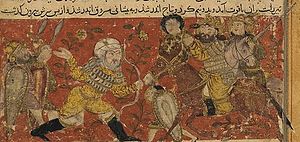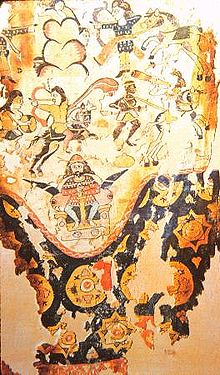Aksumite–Persian wars
Armed conflict of the 6th century CE From Wikipedia, the free encyclopedia
The Aksumite–Persian wars took place in the 6th century, when the Kingdom of Aksum and the Sasanian Empire fought for control over South Arabia. In the 520s, the Aksumite invasion of South Arabia had led to the annexation of the Himyarite Kingdom and the deposition of Dhu Nuwas, who was persecuting the Christian community of Najran. By 570, the subjugated Himyarite king Saif ibn Dhi Yazan sought to end Aksum's hegemony in the region and, after being rejected by the Byzantine Empire, turned to the Persians for military aid. The Persian king Khosrow I agreed upon the stipulation that Himyarite territory would be annexed by the Sasanian Empire in the event of an Aksumite defeat. Subsequently, the Persian army entered South Arabia and secured decisive victories in the Battle of Hadhramaut and then in the Siege of Sanaa, following which the Aksumites were largely expelled from the Arabian Peninsula, excluding Najran. With the establishment of Sasanian Yemen, Yazan was appointed to govern the region. However, four years after, he was murdered by his Aksumite servants. Facing an Aksumite reconquest, the Sasanian Empire mounted a second invasion and re-conquered Yemen by 578, indefinitely ending Aksumite rule outside of Africa. The Persian army general Wahrez was appointed as Yemen's governor, ensuring the suppression of regional pro-Byzantine influence amidst the Byzantine–Sasanian War of 572–591.
| Aksumite–Persian wars | |||||||||
|---|---|---|---|---|---|---|---|---|---|
 Depiction of the Persian army general Wahrez killing the Aksumite king Masruq ibn Abraha with an arrow, from Tarikhnama | |||||||||
| |||||||||
| Belligerents | |||||||||
|
Sasanian Empire Himyarites | Kingdom of Aksum | ||||||||
| Commanders and leaders | |||||||||
|
Khosrow I Wahrez Saif ibn Dhi Yazan † Nawzadh † | Masruq ibn Abraha † | ||||||||
| Units involved | |||||||||
|
16,000 infantry (modern estimate) 800 cavalry (Al-Tabari) | 6,000–10,000 troops | ||||||||
For the next century, the Sasanian Empire maintained army garrisons throughout South Arabia. This period saw the inception of a community known as Al-Abna', which consisted of people whose ethnic lineage was both Iranian and Arab, owing to a high rate of Persian soldiers intermarrying with local Arab women. The Al-Abna' community would go on to play a prominent role during and after the rise of Islam, when most of them joined the early Muslims.
History
Summarize
Perspective
Background
Aksumite invasion of South Arabia
Around 520 AD, Kaleb of Aksum sent a military expedition to Yemen to fight against Dhu Nuwas, a Jewish ruler of the Himyarite Kingdom who had gained notoriety for his ongoing persecution of the Christian community in Najran.[1][2] Following the successful Aksumite invasion, Dhu Nuwas was deposed and executed, and Kaleb appointed a Christian Himyarite native, Sumūyafa Ashwa, as his viceroy. However, around 525, Ashwa was deposed by the Aksumite general Abraha, who declared himself as the king of the new Himyarite–Aksumite Kingdom.[1]
Himyarite rebellion
After Abraha's death, his son Masruq ibn Abraha took over and continued the Aksumite vice-royalty in Yemen and resumed payment of tribute to the Kingdom of Aksum, annexing it to the Aksumite kingdom in Abyssinia. Following these events, Masruq's half-brother, Ma'adi Yakrib (also known as Sayf ibn Dhi Yazan), decided to revolt against him.[2] After being denied aid by Justin II of the Byzantine Empire, Ma'adi Yakrib sought help from Khosrow I of the Sasanian Persian Empire.[2]
First Persian invasion
In response to Maʽd-Karib's request, Khosrow I sent the Sasanian military general Wahrez and his son Nawzadh to Aksumite-ruled Yemen at the head of a small expeditionary force of 800 Dailamite cavalrymen in 570 CE.[3] The Sasanian military, onboard eight ships, sailed around the coasts of the Arabian Peninsula; although two of the ships were wrecked, the rest successfully docked in the Hadhramaut region of southern Arabia.[4] The strength of the Sasanian expeditionary force is variously given as 3,600 or 7,500 (Ibn Qutaybah), or 800 (al-Tabari). Modern estimates place the Sasanian force's numbers at 16,000 men. The Persians sailed from the port of Obolla, seized the Bahrain Islands, and subsequently moved on Sohar, the portside capital of historical Oman; they then captured Dhofar and the remainder of Hadhramaut before landing at Aden.[5]
During the initial invasion, Nawzadh was killed by Aksumite forces.[4] This event led Wahrez to pursue a vendetta against the Ethiopian ruler of Yemen, Masruq ibn Abraha, who was personally executed by Wahrez at the Battle of Hadhramaut. The decisive Persian victory at Hadhramaut marked the beginning of the Aksumite retreat and the subsequent besieging of Sanaʽa by the Persians.

Following the capture of Sanaʽa by Sasanian forces, Wahrez reinstated the former Himyarite king Sayf ibn Dhī Yazan to his throne as a vassal of the Sasanian Persian Empire.[3] Al-Tabari reports that the defining factor of the Persian victory over the Aksumites was the panjagan, a military technology used by the Sasanian military with which the locals were unfamiliar. After the conquest of Yemen and subsequent expulsion of the Ethiopian presence there, Wahrez returned to Persia with a large amount of booty.[6]
Aksumite uprising and second Persian invasion
By 575–578 AD, the Himyarite vassal king Yazan was murdered by his Ethiopian servants, following which the Aksumites returned and re-established their power in the region. In response, the Sasanian military invaded Yemen a second time, headed by a force of 4000 men and led by Wahrez. Yemen was then annexed by the Sasanian Empire as a province, and Wahrez was installed as its direct governor by the Sasanian emperor Khosrow I.[3] Greater Yemen remained under firm Sasanian control until the rise of the Islamic prophet Muhammad in the early 7th century.
See also
- Al-Abnaʽ, a community of people descended from Iranian fathers and Arab mothers after the Aksumite–Persian wars
References
Sources
Wikiwand - on
Seamless Wikipedia browsing. On steroids.
